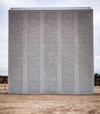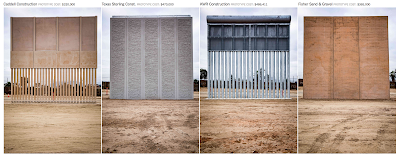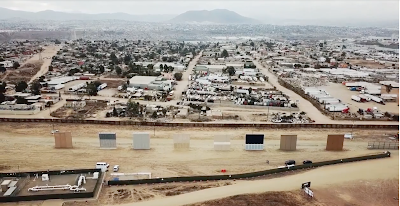


The Funambulist
In calce a questo articolo, ripreso dalla rivista "The Funambulist", riportiamo anche l'articolo orginale "Eight Ways to Build a Border Wall", con le immagini dei prototipi, comparso sul New York Time l'8 novembre 2017. (i.b)
 |
| Dettagli degli otto prototipi dei muri. Fonte: New York Times |
The article unapologetically associates veneer drone footage to comparative shots of the prototypes with titles such as “Concrete or No Concrete,” “Opaque or Transparent,” or “Tube or No Tube?” that we would more eagerly associate with a kitchen-customizing multiple-choice form on a home improvement website, than with a serious examination of the political instrumentalization of architecture’s violence. In presenting a wall project it opposed during the 2016 presidential campaign in the sensational form of a commercial brochure with which US citizens are invited to shop, the NYT brings a tremendous legitimacy to this political project. Rather than examining the very ideological and societal axioms of such a project or insisting on the shattering fact that 10,000 people died attempting to cross this border (killed by heat stroke, dehydration, or by US militias), this article instead analyzes exclusively the “how” of the Wall in the usual adjustment to the new status quo.
Back then, the NYT had proposed to thirteen architects to take part in a “reflection” on the design of this wall reported under the name “A Fence With More Beauty, Fewer Barbs” (in 2008, I had already written about it in an article entitled admittedly-not-so-subtly “How Far Can the Bullshit Go?”). Some architecture offices had declined the offer because “they felt it was purely a political issue,” but others, such as renowned Californian architect, Eric Owen Moss, had answered the call and proceeded to propose an architectural design for this “more beautiful” wall. In his report of the challenge in the NYT (June 18, 2006), William L. Hamilton had written the following: “Eric Owen Moss, an architect in Los Angeles, was more specific with his border as beacon of light. In his design, a strolling, landscaped arcade of lighted glass columns would invite a social exchange in the evening, much like the “paseo,” popular in Hispanic culture. ‘Make something between cultures, which leads to a third,’ Mr. Moss said. ‘Celebrate the amalgamation of the two’.”
It is easy to critique Moss’ position, his romanticist and essentialist rhetoric, and his office’s grotesque design. Similarly, the title of the challenge itself (whether it was introduced to architects under this name or not) has the capacity to mobilize a wide outrage for its radical candidness — in March 2016, during the US presidential campaign, a proposal for a design competition, entitled more soberly “Build the Border Wall?” and its relay in the mainstream architecture platform Archdaily, had triggered (legitimately) infuriated reactions from a certain amount of architects. Of course, beauty has the potential to normalize violent architectures and, in this regard, one can think of the (true or fictitious) story graffiti-artist Banksy told about his experience of painting on the Israeli Apartheid Wall: when an old Palestinian man allegedly told him that he was making the Wall beautiful, Banksy thanked him, to what the old man replied: “We don’t want it to be beautiful, we hate this wall. Go home.” Yet, we should not emphasize the importance of beauty’s normalizing capacities; after all, the architectures of the Israeli apartheid are unanimously recognized as ugly, but such a qualification never compromised their existence.
We nevertheless ought to focus on the other projects sent as a response to the NYT design challenge to realize that the most problematic characteristics of such a call are less to be found in the transformation of the wall from ugly to beautiful, than in its transformation from inert to productive. In his report, Hamilton had written, “Four of the five who submitted designs proposed making the boundary a point of innovative integration, not traditional division — something that could be seen, from both sides, as a horizon of opportunity, not as a barrier.” From James Corner’s “solar energy-collecting strip that would produce what he described as a ‘productive, sustainable enterprise zone’ that attracted industry from the north and created employment for the south” to Calvin Tsao’s “enterprise zone […] as a series of small, developing cities,” we can see how the productivity and usefulness are regarded as mitigating the violence of the border when, in fact, they make it more durable by creating new dependencies on its existence. They also reproduce the North/South exploitative relationships at a local scale involving a border porosity for some (as well as goods and capitals) while making it impermeable for others as Alex Rivera potently illustrates in his 2008 film Sleep Dealer about the maquiladoras of a near future.
After having written my not-so-subtle article in 2008, I remember subsequently debating about this question with US architect and professor Ronald Rael, who, back then, was already engaged in the research work that has been recently published in the form of a book entitled Borderwall as Architecture: A Manifesto for the U.S.-Mexico Boundary (University of California Press, 2017). Although Rael’s approach to the wall is drastically more complex and critical than the capitalist and technocratic “solutions” offered by the architects cited above, part of his design hypotheses regarding the Wall are also attempting to make it more productive, as well as to “institutionalize through models and drawings, events that are already occurring on the wall”. In an interview given for another NYT article, he aptly expresses the contradiction in which he finds himself: “[Rael] makes the argument that we should view the nearly 700 miles of wall as an opportunity for economic and social development along the border — while at the same time encouraging its conceptual and physical dismantling” (Allison Arieff for the New York Times, March 10, 2017). This contradiction is the same than the one analyzed by Eyal Weizman in “The Best of All Possible Walls” (The Least of All Possible Evils, Verso, 2011) when he describes the legal action of some Palestinian lawyers and activists in the Israeli High Court of Justice in Jerusalem arguing for alternative routes for the Israeli Apartheid Wall during its construction in 2004. Weizman’s entire book is dedicated to what he calls “humanitarian violence” in its subtitle: “Humanitarian Violence from Arendt to Gaza.” We can try to define this violence as the consequence of actions undertaken in an effort to mitigate a given violence but, in their compromising negotiation with that it claims to be fighting against, ends up bringing a greater legitimacy and inertia to it than if these actions had not been initiated in the first place.
The NYT’s editorial line could not be more at odds with this concept and, as such, provides one of its most illustrative examples. It is however important to observe that the fundamental difference between the NYT’s positioning and that of the Palestinian lawyers and activists that Weizman describes in their legal attempts to slightly divert the Apartheid Wall’s route in order to locally save the access of farmers to their fields and the junction of houses with the rest of Palestinian towns, is to be found in the fact that Palestinians are the first concerned by the Wall and, as such, have a legitimacy to recognize the inertia of the status quo and negotiate with it even if it brings more weight to it. On the contrary, the NYT represents the interests of a significant part of the US establishment that can afford to live with the political program of the current president when they do not benefit from it one way or another. Its negotiation with this political reality can therefore not act as the catalyst for reform that it would like to embody; on the contrary, it rather produces the profound and durable legitimization of it.
They all stand neatly in a row: eight large panels on a barren dirt patch just a few hundred yards from the San Diego border with Mexico. Unveiled in late October, these are the prototypes for the border wall President Trump has vowed to erect on the southern border. Later this year, the federal government will test the panels for strength and effectiveness.
 |
| Gli otto prototipi dei muri. Fonte: The New York Times |
These prototypes make clear that a border wall is not simple: It can vary considerably in material, shape and cost. And while it is far from clear that Congress will pay for a wall or that any of these designs will be built at wider scale, they are real-life renderings of a promise that fueled much of Mr. Trump’s campaign.
Six contractors have made bids on the wall, and the specific details of their plans are not public. But they allowed us to visit the prototypes, and we asked border security experts and engineers what they saw in each design and what challenges each wall may face.
Every expert agreed on one thing: Finding a design that would work for the entire length of the border would be extremely hard, if not impossible. And many caution that such a wall may never happen.
Some “other than concrete” prototypes incorporate steel, which can be relatively easy to cut with a torch, while pure concrete is not. A hollow steel pipe whose walls are half an inch thick could easily be cut in less than an hour, according to Michael D. Engelhardt, professor of structural engineering at the University of Texas at Austin.
Steel is also malleable. Mr. Engelhardt said that a small hydraulic arm (similar to the “Jaws of Life” used to pry open a crumpled car) could easily be used to make an opening in such a wall: “The equipment is small (could likely fit in a backpack), inexpensive, widely available and can generate many tons of force.”
“Steel can rust really quickly,” said Curtis Patterson, a structural engineer based in San Diego who visited the prototypes with a team of Times journalists. He pointed to several rust spots that had already appeared on one of the prototypes, less than a month after construction.
But some envision the mixed-material walls as having more technological capabilities. They might be called smart walls: walls that incorporate radar, acoustics and other types of surveillance embedded in the infrastructure. One of the contractors bidding on the wall is ELTA North America, an Israeli defense contractor that specializes in radar and communication equipment.
“My sense is they will select multiple awards for these types of infrastructure,” said Jayson Ahern, a former acting commissioner of Customs and Border Protection who was involved in the construction of a border fence during the George W. Bush administration. “Some will be for technology, some for when they just need a wall.”
Michael Evangelista-Ysasaga, the chief executive of Penna Group, which has contracted with the government before but whose prototype bid was rejected, said: “A see-through border wall allows them to know when they are facing threats on the other side, which Border Patrol has long preferred on their wish list. They didn’t want a solid wall. Going through was never the real threat. The real threat is going over or under.”
The only wall that actually has a brick facade is the prototype from Texas Sterling Construction. But in keeping with the guidelines, the pattern appears only on the U.S.-facing side. What Mexico gets to see is a bare concrete wall lined with barbed wire.
It turns out that barbed wire presents its own problems. Mr. Evangelista-Ysasaga said that his company often uses razor wire in prisons and that animals routinely get stuck. For humans, hair and clothing could get tangled in it. Having such wire along the border would be “really inhumane,” he said. “You’re going to read about a whole family dead on a Sunday morning. It’s going to be a human rights nightmare in the international world.”
Many of the contractors added a rounded tube at the top of their prototypes; they believe it will make it far less likely that anyone could reach the top. “It makes it impossible to straddle or use to get a rope ladder across because there is nothing to hook onto,” Deputy Chief Patrol Agent Roy D. Villareal said.
The prototype is also supposed to prevent tunneling at least six feet underground. Both rudimentary and sophisticated tunnels, primarily used to bring drugs into the United States, have been a persistent problem in the San Diego area. Border Patrol officials would not provide any details about what the barriers looked like below the surface, saying only that many went “well beyond” the six-foot minimum.
And Then There’s the Bill
Nearly every expert we spoke to said the cost of a wall could be insurmountable: Congress has not authorized any funding, and Mexican officials have insisted their country will not pay. Cost estimates have varied widely, but an internal report from the Department of Homeland Security pegged it at $21.6 billion.
“It’s not like buying 100 cars, where you have a fixed price,” Mr. Ahern said. “There’s an awful lot of wild cards that people won’t actually know about until they get into the field. Clearly that was our experience before.
“A wall is not a single solution. It is one element of border security.”
There may be no future for any of these walls. And because they sit in a remote industrial section near the border, they are unlikely to become roadside attractions. If nothing else, they stand, for now, as emblems of the administration’s ambitions.